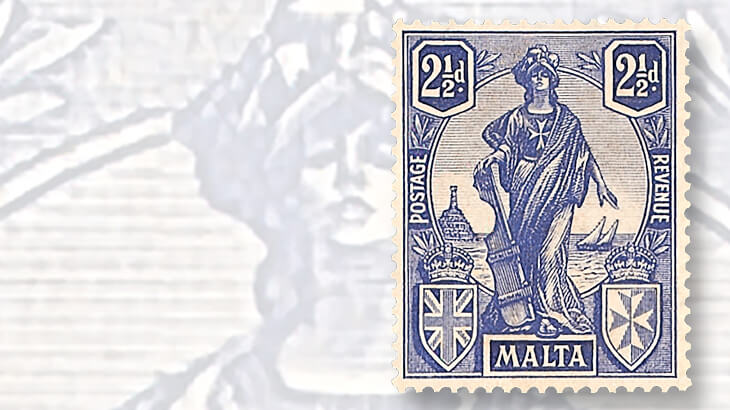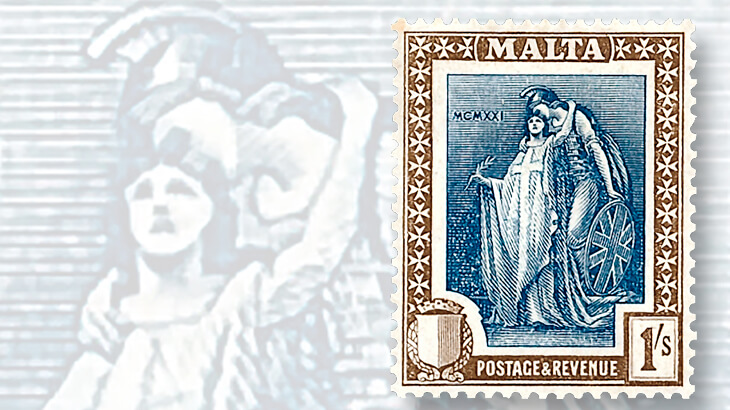World Stamps
Malta’s 1922 Melita issue: Fine art or poorly done stamps?
By Kathleen Wunderly
For being such a small country, Malta carries a weighty history. An archipelago in the central Mediterranean Sea, 60 miles south of Sicily, Malta has physical evidence of more than 7,000 years of human habitation. The native Maltese people are descendants of ancient Carthaginians and Phoenicians, with elements of Italian and other Mediterranean ancestry.
Thanks to its strategic location, Malta always has been popular among roving conquerors, and its invading rulers have included the Arabs, Sicily, the Normans, the Aragonese, the Sovereign Military Order of St. John of Jerusalem (also known as the Knights of Malta), the French, and eventually Great Britain, which formally acquired Malta in 1814. In 1964, Malta became independent and has been a republic since 1974.
The Sovereign Military Order arranged the first postal service on Malta in 1708, but it was reorganized under the French occupation in 1798 and a “Malta” handstamp was introduced.
Connect with Linn’s Stamp News:
Sign up for our newsletter
Like us on Facebook
Follow us on Twitter
The British established regular mail service in 1799, followed by packet service with its own handstamps. A British overseas post office was operational by the mid-1800s, and British stamps were available in August 1857.
Prepayment of postage became mandatory on Feb. 1, 1858. Malta issued its first stamp on Dec. 1, 1860, for domestic use only, with British stamps on all outgoing mail.
After more than a century of British rule, in 1921, following a series of riots in 1919 and subsequent growing unrest, the Amery-Milner Constitution was proclaimed April 30, 1921, granting self-rule to Malta.
An elected Maltese government would administer internal affairs, and Great Britain would oversee defense and foreign matters. Elections were held in August, and a bicameral Maltese Parliament met for the first time on Nov. 1, 1921.
Malta’s officials hoped to have new postage stamps ready by the time the Parliament convened. Some sources say that authorities announced a stamp-design competition on June 17, 1921, and others say that two well-known Maltese artists were asked on that date to submit designs. However it happened, no designs, much less completed stamps, were ready by November’s opening of Parliament. To fill the gap, various Malta issues from 1914-19 received a diagonal overprint in red or black reading “SELF-GOVERNMENT.” As time went on, stamps of 1921 also were overprinted.
As it turned out, new stamps celebrating self-government did not emerge for more than a year — August 1922 — after designs were solicited.
Two different designs were used, divided between the low denominations and the higher ones, and both feature the female allegorical personification of Malta, known as Melita.
The name comes from the Roman town of Melite, the ancient capital of Malta. Melita already had appeared on several of Malta’s stamps, including an 1899 issue (Scott 17), wearing a helmet and carrying a sword and shield.
The Melita design for the lower denominations as well as the highest one (¼ penny, Scott 98; ½d, 99; 1d, 100; 2d, 103; 3d, 105; 4d, 107; 6d, 108; and £1, 114a) was by Edward Caruana Dingli (1876-1950), a native of Valletta who is still considered to be one of the finest artists Malta ever produced. He was a professional artist, also teaching at the Malta Government School of Art.
The Dingli Melita is an older and more robust figure than the version on the 1899 Malta stamp. She wears a long robe with a shawl draping to the ground, with a large Maltese cross on the front of her dress. What appeared to be a rather stylish conical helmet on the 1899 Melita has become a slouchy cap, seemingly topped with a loose pile of rags, on the Dingli version. His Melita braces a large rudder in her right hand, symbolizing Malta steering its own way. In the background are the lighthouse at Fort St. Elmo and a Gozo boat (a sailing vessel commonly used in the Gozo Channel).
Dingli’s Melita is considered one of Malta’s most beautiful stamp designs, and was used much later as a stamp-on-stamp Malta issue in 2011 (Scott 1442). However, at the time, the new design was criticized. In Mekeel’s Weekly Stamp News of May 16, 1927, Capt. H.W. Jessop wrote, “though not in themselves displeasing, [the stamps] did not meet with a very enthusiastic reception either from the general public or from collectors.”
The local press in Malta found fault with the printing and the coloring, calling them “indistinct.” The stamps were printed by typography by Thomas De La Rue & Co. in London, and Jessop felt that the result “falls short of the best work” of that firm. (The £1 denomination, Scott 114 and 114a, was engraved by De La Rue.)
Jessop added that collectors “found additional cause for complaint in the absence from all the values of the Sovereign’s [King George V] head.” This complaint somewhat missed the point of this being a set of stamps celebrating Malta’s new status of self-governing: freed, at least in some ways, from British control.
Local critics had expressed themselves in the daily Il Popolo di Malta newspaper, and on Aug. 4, 1922, Dingli responded, saying that upon seeing samples from the printer, he had expressed dissatisfaction with the execution of his drawing, “which in many respects did not tally artistically with the original.” Dingli said that his original “was copied by hand and alterations were introduced resulting in a totally different effect from that originally intended.”
The artist said that the lighthouse came out looking “like a beehive or the Mosta dome.” The Mosta Dome is a 19th-century Maltese church resembling Rome’s Pantheon, with a huge unsupported dome. Dingli said that his original artwork should have been “reproduced by photography and then engraved.”
The second design of the Melita set of definitive stamps appeared on the higher denominations (1 shilling, Scott 109; 2sh, 110; 2sh 6d, 111; 5sh, 112; and 10sh, 113).
This design was the work of Gianni Vella (1885-1977), who was born in the city of Cospicua, east of Valletta. He studied in Rome and went on to become a prolific artist in Malta, creating religious paintings and frescos as well as political caricatures, landscape paintings, and images of a bygone, romanticized Malta.
This fondness for romanticism is evident in Vella’s Melita design. Very different from Dingli’s serious matron, Vella’s Melita is a lissome maiden in a flowing robe, holding an olive branch in her right hand as she leans back, rather awkwardly lifting her left hand up and around the neck of Britannia, the allegorical symbol of Britain.
Britannia, always female and wearing a Corinthian helmet, is an image dating to first-century Rome. In Vella’s design, Britannia’s right hand rests on Melita’s right shoulder, while her left hand rests on a shield bearing the Union Jack.
Some philatelic writers interpreted this pose as a male Britannia nuzzling the female Melita leaning against him, while others (realizing Britannia is a female figure) called it “a sisterly embrace” or “a possible allusion to their being sisters or maybe mother and daughter.”
To me, Britannia appears at ease while Melita has a focused look that might not bode well for Britannia, who might end up on the receiving end of the judo move that tosses one party forward over the other’s shoulder.
Before 1926, Malta stamps were valid for both postage and revenue use, and the 1922-26 set is inscribed accordingly.
The typographed stamps were printed on chalky paper with watermark 4 of the British Colonial and Crown Agents watermarks as listed in the Scott Classic Specialized catalogue of Stamps and Covers 1840-1940; namely, Multiple Crown and Script CA. The £1 stamps were printed by engraving on ordinary paper, with watermark 4. All of the issues are perforated gauge 14.
The dates of issue of the 1922 stamps seem to have been uncertain, because they are not readily found in the relevant philatelic literature. Jessop’s 1927 Mekeel’s article said he was unable to provide exact dates, and gave anecdotal evidence of which issues a friend found at the general post office in Malta on Aug. 28, 1922.
As it happens, the website of Malta Post (www.maltaphilately.com/en) has a section titled “stamp catalogue” that pictures every Malta stamp with denomination, color, Stanley Gibbons catalog number, and date of issue.
According to these listings, the ¼d, ½d, 1d, 6d, 1sh, and 2sh stamps were issued Aug. 1, 1922. The 2d was issued Aug. 22, and the 3d, 4d, 2sh 6d, 5sh, 10sh and £1 stamps were issued Aug. 28.
To replenish stocks and accommodate changes in postal rates, new colors of previous denominations of the 1922 designs, and several entirely new denominations, were issued in 1923, 1924, and 1926. These are, in chronological order, 1½d (Scott 102), Oct. 1, 1923; 1d (101), April 25, 1924; £1 (114), May 14, 1925; 2½d (104) and 3d (106), Feb. 16, 1926.
Most of the stamps in the 1922-26 set are individually valued in the 2017 Scott Classic Specialized catalog at between $3-$7 each, unused, with the exceptions being the higher denominations, valued from $10-$24, with the 10sh at $70 unused and $175 used, and the £1 at $125 unused and $500 used.
The 2017 Scott Classic Specialized catalog assigns the full set of 17 issues a value of $318.25 unused and $841.75 used.
MORE RELATED ARTICLES
Headlines
-
US Stamps
Oct 7, 2024, 3 PMMcMurtrie dismissed as APS education director following Sept. 21 arrest
-
US Stamps
Oct 7, 2024, 12 PMVasiliauskas named president of Mystic Stamp Co.
-
US Stamps
Oct 6, 2024, 5 PMApgar souvenir card available
-
US Stamps
Oct 6, 2024, 4 PMFirst Continental Congress and U.N. stamps receive Scott catalog numbers










